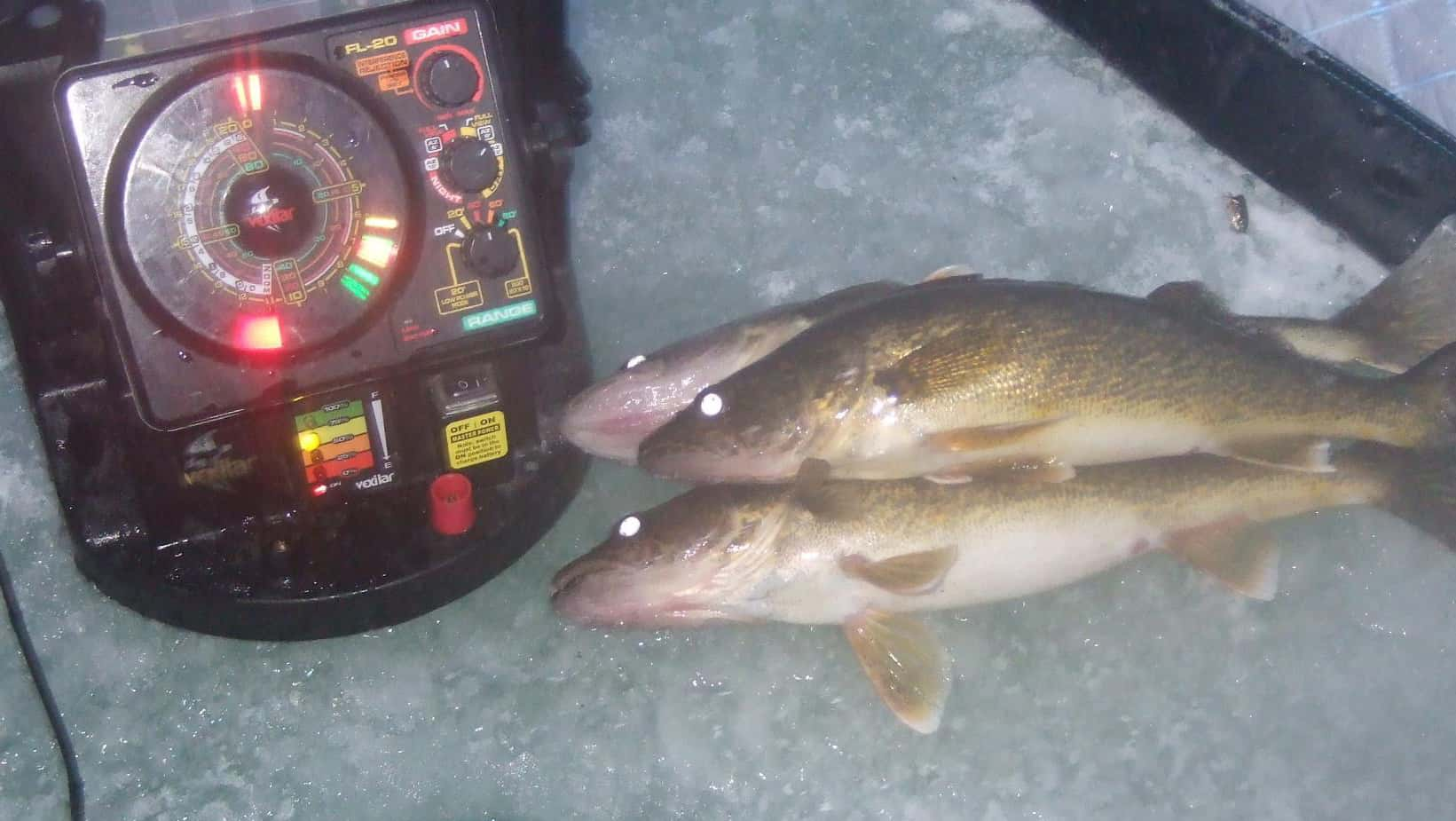
Photo: A good run of fishing produced a trio of keeper walleyes that rose to a spoon jiggled and paused in various cadences above them. Simonson Photo.
By Nick Simonson
There’s an old Irish proverb that wishes good luck to the traveler by stating “may the road rise to meet you.” For anglers, especially those on the ice, it should be more like “may the fish rise to meet you.”
Presentation is one of the key factors for consistently catching fish and the nature of angling through the ice doesn’t leave a whole lot of horizontal options. For that reason, knowing why fish take to a vertical presentation, how to draw them up to a lure and what to do to seal the deal when they do rise to meet a jig or a spoon are vital for success.
Most active fish in the winter will rise to take a lure that is worked in the water column above them, whether it’s just a few inches or up to several feet. Even neutral fish will come off the bottom or out of the depths to inspect a jig or a spoon worked up higher in the water column. The reason for this is simple armchair biology. The eyes of most fish species are mounted to provide an upward viewing angle. They see everything to each side, out in front of them some distance and up toward the surface of the water. Therefore, they are more likely to see an item of prey that is above them than below them, where their viewing angle is limited.
When fish are marked on or come in close to the bottom, a presentation of 12 to 24 inches above them is ideal in gauging their aggressiveness or at least in determining their interest. If an aggressive fish doesn’t speed up to the bait, lower it slightly with a few jiggles and hops. Particularly with perch and bluegills, when watching a sonar screen, the highest-sitting fish in the column may not be the first fish to the bait.
Oftentimes, a smaller specimen will race past that top fish to seize the opportunity. On a hot bite, that first fish might trigger a rush of strikes, drawing fish of all sizes (including the big one that didn’t seem all that interested at first) up to the bait, and the fishing is good in that spot for some time thereafter. This scenario plays out across species, from bluegills, perch and crappies on up to walleyes.
Frequently, however, anglers are forced to finesse those fish into biting. For this situation, an elevated presentation also helps draw their attention. Then it’s up to the angler to convince them to bite. When fishing panfish, a sensitive graphite rod with a spring bobber helps manage a finesse presentation and often only a slight jiggle and pause above the fish will start them moving in for a closer look.
Remember when fishing panfish, that they have relatively big eyes and small mouths and dine on the tiniest pieces of food. For this reason, be subtle with a presentation when a slow-rising fish (neutral or just slightly active) moves in to inspect. The closer a panfish gets, the more subtle the jiggles and hops and the longer the pauses should be. Sometimes, as a blip closes in on the Vexilar, all it takes is the tap of a finger against the rod handle, or just a slight squeeze on the grip to impart the necessary movement to trigger a bite. In these instances, watch the spring bobber and line carefully as the bite from a neutral fish will be very subtle, telegraphed as just the slightest twitch.
When fishing active predators, like walleye and pike, the opposite may very well be the case. The fish may approach cautiously but be triggered into biting by a wild jigging motion which pulls the bait up and away from them, inducing a reaction strike. Experiment with both methods, or find something in the middle that sets big fish off.
There’s one common instance where a bait lower than the fish can trigger a bite. When over a school of fish that have cooled off and are not biting, and none will rise to meet an offering, try letting the lure freefall through the group and hit bottom before raising it above them again. This rapid descent and lifting of a lure may trigger the curiosity of some of those fish from the bottom of the school to ascend and take to a jig or a spoon. The disturbance caused by the lure may also free debris from the bottom, attracting fish and restarting a slowed bite.
After a few outings, one is better able to pattern the targeted species on a water and how they react to a raised lure. This season on the ice, start above any quarry and then work down to them or make them come to the offering with a series of jiggles, hops, taps and pauses.
Adjusting a presentation based on how fish view their prey will help elevate success this season and the fish will rise to meet you.

